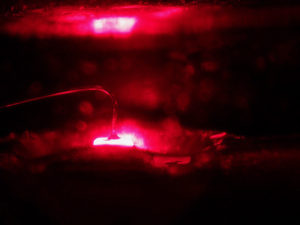Read MCU PIC18F4450 Software
Read MCU PIC18F4450 Software from its memory needs to disable its protection over the flash and eeprom, normally speaking the memory will be locked by the designer who develop the firmware and download it into microcontroller PIC18F4450 in the format of binary or heximal.

Read MCU PIC18F4450 Software from its memory needs to disable its protection over the flash and eeprom, normally speaking the memory will be locked by the designer who develop the firmware
This family of devices offers the advantages of all PIC18 microcontrollers – namely, high computational performance at an economical price – with the addition of high endurance, Enhanced Flash program memory. In addition to these features, the PIC18F4450 family introduces design enhancements that make these microcontrollers a logical choice for many high-performance, power sensitive applications.
All of the devices in the PIC18F2450/4450 family incorporate a range of features that can significantly reduce power consumption during operation. Key items include:
· Alternate Run Modes: By clocking the controller from the Timer1 source or the internal RC oscillator, power consumption during code execution can be reduced by as much as 90%.
· Multiple Idle Modes: The controller can also run with its CPU core disabled but the peripherals still active. In these states, power consumption can be reduced even further, to as little as 4% of normal operation requirements.
· On-the-Fly Mode Switching: The power-managed modes are invoked by user code during operation, allowing the user to incorporate power-saving ideas into their application’s software design.
· Low Consumption in Key Modules: The power requirements for both Timer1 and the Watchdog Timer are minimized. See Section 21.0 “Electrical Characteristics” for values.
Devices in the PIC18F2450/4450 family incorporate a fully featured Universal Serial Bus communications module that is compliant with the USB Specification Revision 2.0. The module supports both low-speed and full-speed communication for all supported data transfer types. It also incorporates its own on-chip transceiver and 3.3V regulator and supports the use of external transceivers and voltage regulators after extract mcu ST62T15C6.
All of the devices in the PIC18F2450/4450 family offer twelve different oscillator options, allowing users a widerange of choices in developing application hardware. These include:
· Four Crystal modes using crystals or ceramic resonators.
· Four External Clock modes, offering the option of using two pins (oscillator input and a divide-by-4 clock output) or one pin (oscillator input, with the second pin reassigned as general I/O).
· An INTRC source (approximately 31 kHz, stable over temperature and VDD). This option frees an oscillator pin for use as an additional general purpose I/O. A Phase Lock Loop (PLL) frequency multiplier, available to both the High-Speed Crystal and External Oscillator modes, which allows a wide range of clock speeds from 4 MHz to 48 MHz.
· Asynchronous dual clock operation, allowing the USB module to run from a high-frequency oscillator while the rest of the microcontroller is clocked from an internal low-power oscillator.
The internal oscillator provides a stable reference source that gives the family additional features for robust operation:
· Fail-Safe Clock Monitor: This option constantly monitors the main clock source against a reference signal provided by the internal oscillator. If a clock failure occurs, the controller is switched to the internal oscillator, allowing for continued low-speed operation or a safe application shutdown.
· Two-Speed Start-up: This option allows the internal oscillator to serve as the clock source from Power-on Reset, or wake-up from Sleep mode, until the primary clock source is available.
Tags: read out mcu flash archive,read out mcu flash code,read out mcu flash content,read out mcu flash data,read out mcu flash eeprom,read out mcu flash file,read out mcu flash firmware,read out mcu flash information,read out mcu flash memory,read out mcu flash program

